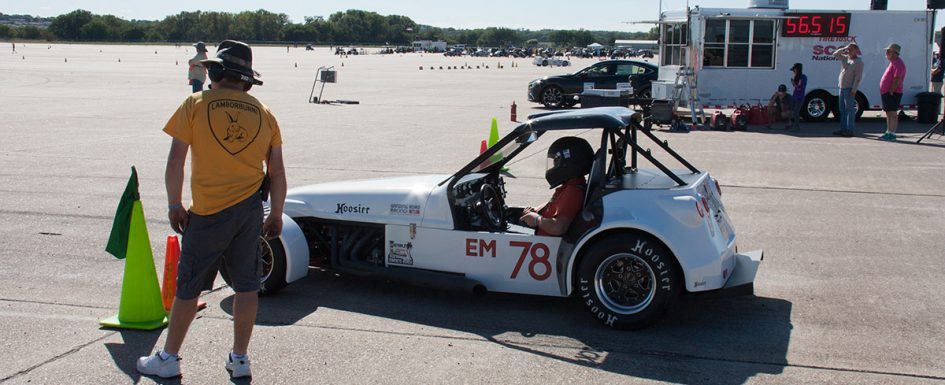The greatest challenge in autocross is that we get a very limited set of runs within which to put in our best performance. This is made even harder at national level events, where we only get 3 runs on each course. With only a few opportunities to learn the course, find the right places to attack, fix mistakes, etc, having a well thought out strategy is critical! This brings up the often-asked question…
What should we do on our first run?
Should we attack hard to test the limits?
What should we do if we hit a cone?
I asked several successful autocrossers about this and got a variety of opinions. I’ve tried to dissect the thinking behind their advice to get to the underlying pros and cons. It is important to understand that the advice anyone gives us is either what works for them, or what someone else once told them. In other words, it may or may not work for us, and we each have to figure out an appropriate strategy for ourselves.
Let’s go through a “decision tree” of factors we should consider in order to come up with our strategy.
1. How well do you perform under pressure?
The single most important factor in determining our optimal approach for run #1 is being aware of how we perform under pressure. Everything else is secondary because no matter what benefits there may be to taking more risks, none of it matters if our ability to perform is compromised.
Imagine this scenario: You have coned your first 2 runs. Are you able to put down a strong 3rd run, or does the pressure force you into making another mistake, or do you find yourself backing off to get a decent time in? Does the answer change based on whether it is a local event, or day 1 or day 2 of national competition?
Imagine an even simpler scenario: You are at the start line for your first run. How do you feel?
Setting aside our bravado and egos, the fact is, most of us do not perform our best when we are under pressure. Our confidence gets shaken and our nervous energy spikes, making us less likely to make good decisions, which depending on our temperament results in either overly cautious behavior (putting in a safe/slow 3rd run), or overly risky behavior (causing another mistake laden run).
This is why the most common advice is to put in a conservative first run that we can bank on. It alleviates some pressure; we get a decent time in the books, and it gives us something to build on.
Most of us would like to think that we are cool, calm, and collected under pressure, but we have to set that aside and evaluate ourselves honestly. Do we commonly make mistakes when it comes down to the wire? Do we often “cone away the win”? If you (like most people) do not thrive under pressure, it’s probably better to start out with a slightly conservative first run.
On the other hand, if you do handle pressure well, or are actively trying to get better at it, the next thing to consider is…
2. How do you approach the limit?
Are you more comfortable approaching the limit from under, or do you prefer to go over the limit and then dial it back? Are you better at sensing the limit from below or above? Knowing what our preferences and strengths are can help inform a more effective strategy for the first run.
If you are better at sensing the limit when approaching from below (i.e. a bottom-up driver), you are someone who has greater sensitivity to the difference between driving at 97%, 98%, and 99% than the difference between 101%, 102%, and 103%. In other words, you are acutely aware of how much you may be under the limit, but once you go over, it is harder for you to tell if you were just a little bit over, or more significantly over. Conversely, if you are better at sensing the limit from above (i.e. a top-down driver), you have a much greatest sensitivity for exactly how far over the limit you are, but have a harder time telling how far under the limit you may be.
This has major implications for our first run strategy. Remember, our goal is to get the fastest time possible in 3 runs, by getting as close to the limit as possible. The approach that you choose should be the one that maximizes your chances of finding the limit.
If you are a bottom-up driver, it makes much more sense to put in a safer first run. That way, not only do you have a good run in the bank, but because you are more acutely sensitive to how much under the limit you were, you’ll have a better chance of making the right adjustments on subsequent runs to go faster. On the other hand, if you are a top-down driver, a safe/clean run is much less useful or informative because you will have a less clear idea of how far under the limit you were and where you could have pushed harder.
Despite what type of limit sensitivity we have, the fact is, it is much easier to correct the mistake of being under the limit (just add speed). Correcting the mistake of being over the limit takes a more complex set of corrective actions (counter steering, speed reduction, etc), and often involves being out of position or off line, which makes recovery take longer, and costs more time. Therefore, the next thing to consider is…
3. Are you adept at recognizing and fixing mistakes?
As we covered in our previous discussions about execution errors and game plan errors, our ability to recognize and fix mistakes directly impacts our ability to make adjustments on the fly. Are you able to quickly tell when a mistake cost you a few hundredths or a tenth? Are you able to identify, while driving, places where you can further optimize your line?
Relatedly, once you recognize that you have made a mistake, how quickly are you able to correct it? How well are you able to adapt on the fly to minimize the time lost because of the mistake? If the car begins to oversteer, do you find yourself reacting a bit late, and letting the slide become severe such that you lose lots of time? Or are you able to catch the slide early, maintain your momentum, and minimize the time loss? If the car understeers when you enter a corner too fast, do you find yourself struggling to get the car turned, or are you able to maintain your momentum on a different/wider arc?
The better we are at recognizing and fixing mistakes, the more we can (and should) attack on the first run. Here’s why…
Nobody gets a perfect run in 3 runs. Even the greatest autocrosser of all time does not achieve a perfect run in just 3 attempts. The winner, every single time, is the person who stayed as close to the limit as possible, while making the fewest (and least severe) mistakes. Our challenge is to get better at recognizing mistakes, and developing our car control skills to minimize their effect. The better we get at this, the more aggressively we can attack the first run.
Some of the more common 3-run strategies that came up in my conversations with the more successful drivers were:
- Conservative first run, very aggressive second run, clean up mistakes on the third run.
- Conservative first run, slightly more aggressive second run, more or less aggressive on the third run depending on how the second run went.
- Aggressive first run, make necessary adjustments on the second and third runs.
- Very aggressive first run, conservative second run, aggressive third run.
Think through this for yourself and come up with a strategy that is specific to your strengths and preferences.
TAKE ACTION: Regardless of whether you utilize a safer or more aggressive approach on your first run, what will you do if you happen to hit a cone; will you stick with your plan for the remainder of the run, or change it? Take into account your own mental framework. Would you prefer to stick with the plan to know what the time would have been regardless of the cone? Would you prefer to up the aggression for the rest of the run to see what you can get away with, knowing that you may make even more mistakes, and not know where you actually stand? Or something else?


Timely topic, thanks Vivek. Last weekend my codriver and I were a second off the pace after morning runs and scratching our heads. First afternoon run I decided to expect more from the car and “overdrive” a bit in a bid to find the time. I was dirty but found the time and the data told the story. We were able to see the time in the data and execute on it to improve our times. That experience is causing me to re-evaluate the merits of my typically safe first run.
That’s fantastic. Challenging our own assumptions and habits is one of the most important ways to find improvements.
Again, thank you so much for these insights! They just might turn this middle-aged wannabe into a decent driver ; )
Glad they’re helping 🙂
terrific article! have you thought about writing a similar one about different approaches to slaloms? i have had several different national champs and instructors advocate different approaches and driving styles to slaloms, none of which really worked for me until Danny Popp said what worked for him was being on the back side of the second cone.
Liz, apologies for the late reply! I actually wrote a very detailed analysis of slaloms, which is available to anyone who signs up for the email list. The link is on the home page 🙂